
We’ve all heard the term superfruit or superfoods, there is not one definition that is recognized by the different health organizations around the world, and there are a lot of discussions around what those terms truly mean. However, both blueberries and pomegranate are often referred to as superfruits. The following will explain the benefits of each of these berries and why they are considered superfruits.
Blueberries
Blueberries are in the Cyanococcus and are within the genus Vaccinium, this is gibberish to most of us, but other berries in this family are, cranberries, bilberries, huckleberries and Madeira blueberries. Blueberries are often classified as either lowbush or highbush. The lowbush variety are usually wild, these bushes are rarely more than nine inches off the ground, and they generally produce a smaller berry. The highbush variety can grow to be as tall as four meters, they produce larger sized berries, and are the variety that is most often used cultivation. Fun fact, blueberries are the highest produced fruit in Canada, accounting for 29% of the countries total fruit sales.
These berries are considered to be a superfruit by some for many reasons: blueberries have one of the highest amount of antioxidants out of any other fruit, they have a very high content of flavonoids (preliminary research has shown that flavonoids may be helpful in cancer prevention and help prevent and treat several cardio vascular diseases, and has been shown to have antibacterial properties), and these berries are packed with nutrients.
This small but mighty little blue berry is packed with nutrients, as mentioned above. In 100g, approximately 2/3 of a cup, of raw blueberries there is approximately 12% DV (daily value) of vitamin C, 16% DV of vitamin K, 15% DV of manganese, and 10% of our daily dietary fiber requirements. In case you missed it from other articles, the Canadian Food Guide states that 5% or less of the DV is a little, and 15% or more of a DV is considered a lot. So according to these standards blueberries are a good source of vitamin C and fiber, and a great source of vitamin K and manganese.
Pomegranate
Pomegranates are native to the Mediterranean region, and an area stretching from Iran to northern India. These berries, yes, botanically they are considered berries, are from the Lythraceae family and is a deciduous shrub, which are often used as ornamental trees in parks and gardens. This historically symbolic fruit can produce anywhere from 200 to 1,400 seeds. Pomegranates are not commonly grown in North America; in fact, they are mostly only grown in parts of Arizona and California. They are more commonly grown in the Mediterranean, the Middle East, southeast and Central Asia, and in northern parts of Africa.
In 100g, approximately 2/3 of a cup, of raw pomegranate, there is approximately 15% of our daily dietary fiber requirements, 12% DV of vitamin C, 15% DV of vitamin K, 6% of thiamine (B1) and vitamin B6, 8% pantothenic acid (B5), 10% DV of folate (B9), and 6% DV of manganese. According to the Canadian Food Guide standards pomegranate is a good source of vitamin C, B1, B5, B6, B9, and manganese, and a great source of fiber and vitamin K.
The high fiber content in pomegranate is almost entirely in the seed. So, if you’re someone who prefers to spit the seeds out, you’re actually missing out on a great source of fiber and a lot of micronutrients. Pomegranates are also considered a superfruit by some, however, there is significantly less research on pomegranates and their health benefits. This bright red fruit also has a lot of antioxidants, though not as many as blueberries.
Results
After all that can you really choose between these two gorgeous fruits? I know I can’t. They’re both excellent sources of nutrients and are easy to add to a veg diet. Blueberries are great in muffins, on granola, or right out of the fridge. Pomegranates are a great addition to a salad, wonderful in smoothies, and of course, just like blueberries, are a great treat to pop into your mouth and enjoy the deliciously juicy arils.






